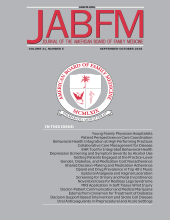Abstract
Objective: This study examined the age-associated rate of incomplete mammograms requiring additional testing based on Breast Imaging–Reporting and Data System (BIRADS) score.
Methods: A retrospective, observational study design from a tertiary medical center was used to evaluate which explanatory variables significantly predicted whether a woman had an incomplete mammogram. An incomplete mammogram was defined as a BIRADS score of 0 (requiring further imaging), whereas a benign process was defined as a BIRADS score of 1 or 2. Explanatory variables included traditional clinical factors (age, race, and menopausal state).
Results: During the study period, 20,269 subjects were evaluated. The majority of the patients were white (n = 12,955; 64.6%) and had a BIRADS score consistent with a benign finding (n = 17,571; 86.6%). Premenopausal state (odds ratio [OR], 1.38; 95% CI, 1.27–1.50), white race (OR, 1.18; 95% CI, 1.08–1.29), and younger age (OR, 1.38; 95% CI, 1.27–1.50) significantly increased the odds a woman had an incomplete study.
Conclusions: In this cross-sectional, single-institution analysis, premenopausal state and white race are associated with an increased rate for incomplete mammograms. Patients should be counseled appropriately before the initiation of screening.
Breast cancer is the most frequently diagnosed cancer among women, accounting for 28% of the estimated new cases of cancer.1 The recent US Preventive Services Task Force guidelines included recommendations2 of delaying the initiation of screening mammography for average-rate women until age 50 years, based in part on the risk of false-positive findings and the need for additional imaging.2 This quickly elicited a response from both the American Cancer Society and the American Congress of Obstetricians and Gynecologists with their own reaffirmations to continue screening women beginning at age 40 years.3
The disparities between the 3 groups prompted an assessment of data from own our institution, a tertiary care facility that provides both indigent and referral care to women in the state of Kentucky. We examined which explanatory variables predicted whether a woman had an incomplete screening mammogram, which requires additional testing based on Breast Imaging–Reporting and Data System (BIRADS) score. A BIRADS score of 0 indicates that a woman requires further imaging or need for review of previous mammograms.4 Identifying those women who may need further imaging may help with counseling and scheduling screening mammograms in certain patient populations.
Methods
A retrospective cross-sectional institutional review board–approved study was performed on 20,283 consecutive subjects from the general gynecology clinic who were sent for screening mammography from January 2004 to December 2006. Fourteen women were excluded for a diagnosis of cancer and/or a BIRADS score of 3 or higher. A BIRADS score of 0 defined an incomplete mammogram, whereas a BIRADS score of 1 or 2 represented a complete, benign mammogram. Several clinical factors were evaluated including age, race, BIRADS score, and premenopausal state (age <51 years). Multiple logistic regression techniques were used to evaluate whether age, race, and premenopausal stage predicted whether a woman had an incomplete mammogram. All main effects were evaluated for significance at the 0.05 level. Secondary analyses investigate if any 2-way interaction effects existed. The Hosmer-Lemeshow χ2 test was used to evaluate model-fit. The SPSS statistics program, version 19 (IBM, Chicago, IL) was used for all analyses.
Results
Data were collected from 20,269 subjects who were evaluated from 2004 to 2006. A majority of the women were white (n = 12,955; 64.6%) and had a benign BIRADS score (n = 17,571; 86.6%), whereas the age groups were more evenly disbursed (50–59 years: n = 10,119, 49.9%; 40–49 years old: n = 10,149, 50.1%). As seen in Table 1, white race (odds ratio [OR], 1.18; 95% CI, 1.08–1.29); premenopausal state (OR, 1.38; 95% CI, 1.27–1.50); and younger age (OR, 1.38; 95% CI, 1.27–1.50) significantly increased the odds a woman had an incomplete study. No 2-way interaction effects were found to be significant; therefore, the interaction effects were not included in the model or presented in this report. The model fit the data well (χ2 = 0.875; P = .928).
Clinical Characteristics of Patients with Incomplete Mammogram Findings
Conclusions
Age, premenopausal status, and white race were shown to increase significantly the odds a woman had an incomplete screening mammography. Put another way: white women, woman who were premenopausal, and younger women were significantly more likely to have an incomplete mammogram. Biologically plausible reasons include increased density of breast tissue at younger ages and during the premenopausal time period. Our study is limited by its retrospective nature, which limited our information regarding previous mammograms and follow-up issues with further imaging. Our findings, however, are consistent with findings from the US Preventive Services Task Force, which reports an increased rate of additional imaging based on age (40–49 years [84.3 per 1000 per screening round] vs 50–59 years [75.9 per 1000 per screening round]).2 At our institution the radiologist is not always available on site for the follow-up imaging, and most patients must follow up as needed after the mammogram report is complete, with the potential of increased stress and concern about a cancer diagnosis.
Future study will be needed to ascertain if further imaging is associated with any clear, specific clinical cancer benefit. Identifying those patients with whom incomplete mammograms are associated may help with routine annual health care. It is our hope that clinicians will be better able to counsel their patients before screening initiation so that informed decision making can occur and expectations may be set.
Notes
-
This article was externally peer reviewed.
-
Funding: none.
-
Conflict of interest: none declared.
- Received for publication April 1, 2011.
- Accepted for publication June 22, 2011.






